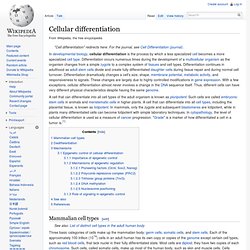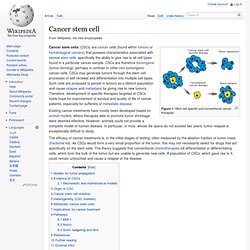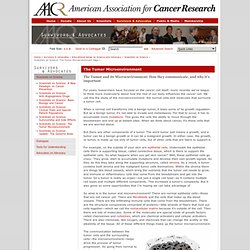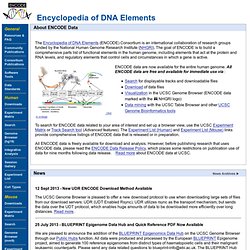

Ashish Bihani
Other Interests. Science & Technology. Biology. SOP : cancer. Proteins. Cellular differentiation. Mammalian cell types[edit] Three basic categories of cells make up the mammalian body: germ cells, somatic cells, and stem cells.

Each of the approximately 100 trillion (1014) cells in an adult human has its own copy or copies of the genome except certain cell types, such as red blood cells, that lack nuclei in their fully differentiated state. Most cells are diploid; they have two copies of each chromosome. Such cells, called somatic cells, make up most of the human body, such as skin and muscle cells. Cells differentiate to specialize for different functions. Germ line cells are any line of cells that give rise to gametes—eggs and sperm—and thus are continuous through the generations. Pluripotent stem cells undergo further specialization into multipotent progenitor cells that then give rise to functional cells. Dedifferentiation[edit] A small molecule dubbed reversine, a purine analog, has been discovered that has proven to induce dedifferentiation in myotubes.
Mechanisms[edit] Cancer stem cell. Figure 1: Stem cell specific and conventional cancer therapies Cancer stem cells (CSCs) are cancer cells (found within tumors or hematological cancers) that possess characteristics associated with normal stem cells, specifically the ability to give rise to all cell types found in a particular cancer sample.

CSCs are therefore tumorigenic (tumor-forming), perhaps in contrast to other non-tumorigenic cancer cells. CSCs may generate tumors through the stem cell processes of self-renewal and differentiation into multiple cell types. Such cells are proposed to persist in tumors as a distinct population and cause relapse and metastasis by giving rise to new tumors. Therefore, development of specific therapies targeted at CSCs holds hope for improvement of survival and quality of life of cancer patients, especially for sufferers of metastatic disease. The efficacy of cancer treatments is, in the initial stages of testing, often measured by the ablation fraction of tumor mass (fractional kill). American Association for Cancer Research - AACR. Scientists on Science: The Tumor Microenvironment Page 1. The Tumor and its Microenvironment: How they communicate, and why it’s important For years researchers have focused on the cancer cell itself; more recently we’ve begun to think more molecularly about how the rest of our body influences the cancer cell.

We call this the study of the microenvironment: the normal cells and molecules that surround a tumor cell. When a normal cell transforms into a benign tumor, it loses some of its growth regulation. But as a benign tumor, it's not able to invade and metastasize. For that to occur, it has to accumulate more mutations. But there are other components of a tumor.
For example, on the outside of your skin are epithelial cells. So what is in the tumor and microenvironment? The communication between the tumor cells and the surrounding cells—the microenvironment—helps drive the process of tumor progression. ENCODE Project at UCSC. 12 Sept 2013 - New UDR ENCODE Download Method Available The UCSC Genome Browser is pleased to offer a new download protocol to use when downloading large sets of files from our download servers: UDR (UDT Enabled Rsync).

UDR utilizes rsync as the transport mechanism, but sends the data over the UDT protocol, which enables huge amounts of data to be downloaded more efficiently over long distances. Read more. 25 July 2013 - BLUEPRINT Epigenome Data Hub and Quick Reference PDF Now Available We are pleased to announce the addition of the BLUEPRINT Epigenomics Data Hub on the UCSC Genome Browser through our Public Hubs function. Also the ENCODE Quick Reference Card is now available in PDF courtesy of OpenHelix on the ENCODE Education and Outreach page. 28 May 2013 - ENCODE portal changes: New Link to NHGRI Tutorials, New External Software Tools Page, Updates to Publications including New 2013 Consortium Papers Section The ENCODE portal was updated to include informative new and expanded pages. StemBook. STAR - Software Tools for Academics and Researchers. GenePattern: Home. Olympus Microscopy Resource Center. Free programs to open any file extension!